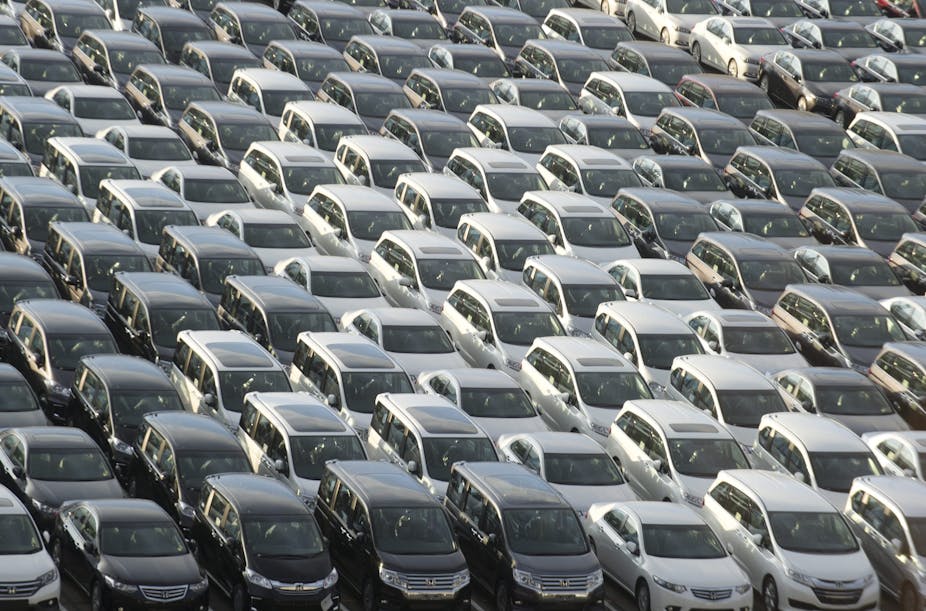The federal government’s new Energy White Paper puts a lot of emphasis on getting more economic benefit from our energy use. But it has left out one obvious policy that could help: mandatory greenhouse emissions standards for all imported new and second-hand vehicles.
This is a surprising omission, considering that the government’s 2013 Emissions Reduction Fund Green Paper acknowledged that “vehicle emission standards have been implemented with great success in many countries”. Why not here too?
It’s doubly surprising in light of the federal government’s recent pledge to embrace energy efficiency for vehicles. At last year’s G20 Brisbane summit, it developed an Energy Efficiency Action Plan which aims to prioritise improving vehicles emissions standards in G20 countries, by introducing more stringent fuel-efficiency requirements for new vehicles.
The government is also preparing to provide details of how its proposed changes to the Motor Vehicle Standards Act will impact on the existing regulations. If it is to uphold its G20 fuel-efficiency pledge, then it needs to include the introduction of mandatory fuel-efficiency or greenhouse emissions standards for all new passenger and commercial vehicles.
With the domestic automotive industry coming to an end in 2017, now is as good a chance as any.
A long time coming
Curbing vehicle emissions has been on the agenda for a long time. In 2009, the Council of Australian Governments (COAG) recommended regulating vehicle carbon dioxide emissions as part of its response to the Henry Tax Review. In 2010, the Labor government’s Prime Minister’s Tax Group on Energy Efficiency also called for motor vehicle emissions standards to be introduced. Other Energy Green and White Papers and related federal government reports have supported the introduction of similar standards, such as the 2014 Emissions Reduction Fund White Paper acknowledged the successful adoption of vehicle emission standards in the European Union and the United States.
Last month’s federal government Issues Paper on setting Australia’s post-2020 emissions target suggested that emissions-reductions policies “…could include fuel efficiency standards for light and heavy vehicles” – although it also added that the government will need to “consult with business and the community” before taking on this policy measure.
Australia lagging behind
What the government also needs to acknowledge is Australia’s poor record on vehicle fuel efficiency in comparison with many other nations. Its planned consultation with business and community should also include a warning that unless Australia introduces proper emissions standards, it risks becoming a dumping ground for high-emissions new and second-hand vehicles.
Australia is one of the remaining three largest markets and the only OECD country without an official fuel efficiency target. According to an energy scorecard for the 16 OECD nations released last year by the American Council for an Energy-Efficient Economy, Australia ranked 10th overall for energy efficiency, but came last on the fuel economy of passenger vehicles and on the setting of future standards.
Australia’s poor performance in reducing vehicle carbon emissions has contributed to its current ranking as the world’s highest per capita emitter of greenhouse gases. What’s more, its failure to introduce regulatory carbon dioxide emission standards has encouraged global car manufacturers to dump and sell their higher-emitting vehicles in Australia.
A dumping ground for high-emissions cars
More than 70% of light vehicles sold in the world last year were subject to mandatory emissions standards. Global car manufacturers are required to meet the regulatory emissions standards in the country of manufacture. For example, manufacturers selling new cars in the European Union must pay a penalty if the average for their fleet exceeds 130g of carbon dioxide per km.
Manufacturers will therefore be encouraged to sell their higher-emission vehicles in countries with no regulatory standards, such as Australia. This explains why multinational manufacturers tend to have higher average emissions in Australia than in Europe.

If the federal government is serious about meeting its G20 pledge to improve vehicle energy efficiency and emissions, it needs to introduce emissions standards that will apply to all new and second-hand light vehicles sold in Australia. Without these new standards, there would be very little to stop international manufacturers from sending us their least efficient, most polluting cars.

